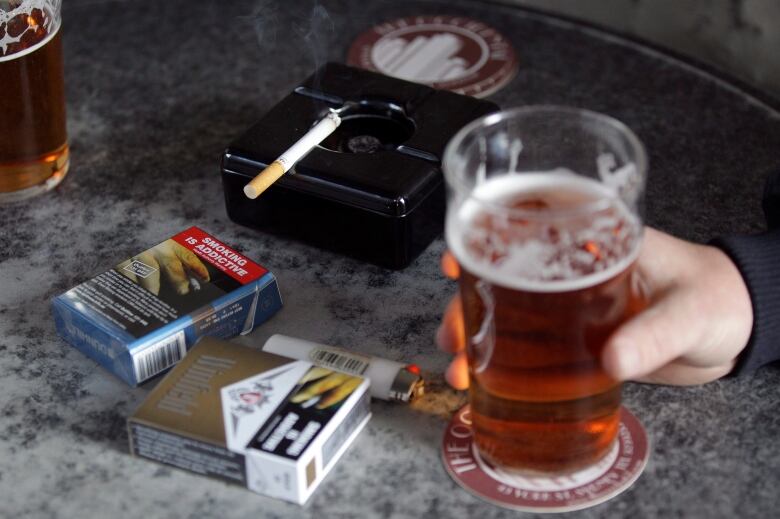E-cigarettes 'may be a gateway for kids that might not otherwise be smoking'
Many Canadian students surveyed said they'd have no problem accessing cigarettes and tobacco products

More than a quarter of Canadian students in grades 10 to 12 say they have tried e-cigarettes, according to a new report.
Health Canada released the results Wednesday of its Canadian Student Tobacco, Alcohol and Drugs Survey for the 2014-15 school year.
A total sample of 42,094 students in grades 6 to 12 completed the survey.
For the first time, the survey asked about e-cigarette use. Among those in grades 10 to 12, nine per cent used e-cigarettes in the previous 30 days. About27 per cent had tried e-cigarettes.
- Anti-smoking advocates want to force 'end game' in war against tobacco
- Flavoured tobacco products show widespread appeal to surveyed youth
The emerging and rapidly growing use of e-cigarettes by youth is a concern to Dr. Robert Reid, deputy chief of the division of prevention and rehabilitation at the University of Ottawa Heart Institute.
"In some cases, their first exposure to a nicotine-containing product is coming from e-cigarettes," Reid said."There's some suggestion from this data that in fact that may be the case."
The public health concern about e-cigarettes surrounds their potential as a gateway for young people to use cigarettes.
"They may be a gateway for kids that might nototherwise be smoking to have them try nicotine and then graduate tocigarettes afterward," Reid added.
Based on the survey findings, the researchers estimated about 610,000 students or 24 per cent of thosein grades 6 to 12 have tried cigarettes, e-cigarettes, or both cigarettes and e-cigarettes.
About 18 per cent of students in grades6 to 12tried smoking a cigarette,even just a puff, down from 24 per cent in 2012-13.
"It is encouraging that teenage smoking is on the decline," said Rob Cunningham, a senior policy analyst with the Canadian Cancer Society.
"But given that the overwhelming majority of smokers begin as teenagers, there is so much more that needs to be done. Implementation ofplain packagingand a strengthened Health Canada tobacco strategy would make a big difference,"he added in anemail.
Almost one in four studentsthought there was "no risk" of harm from using an e-cigarette once in a while, compared to nine per cent who thought there was "great risk."

Most students (65per cent) thought there was "great risk" of harm from smoking cigarettes on a regular basis.
Access remains an issue, Reid said. The decline in youth smoking rates is a tribute to 15 years of educational programs and changing social norms, which has led to fewer smokers to influence them, Reidsaid.
Many students in grades 6 to 12 (47 per cent) thought it would be "fairly easy" or "very easy" to get an e-cigarette if they wanted one.
Legalizing marijuana
Another combustible, cannabis, was used by 17 per cent of students in grades 7 to 12in the previous year. That's down from 19 per cent in 2012-13.
Youth pot use is worth watching closely since all combustibles pose health risks from cardiovascular and respiratory standpoints, Reid said.
"It remains to be seen what's going to happen with this as there's a movement towards legalizing marijuana," Reid said. "Certainly in the past, the experience has been as things become more available they've tended to be used by younger people, as well in greater quantities."
About 18 per cent of students in grades6 to 12tried smoking a cigarette,even just a puff, down from 24 per cent in 2012-13.
"It is encouraging that teenage smoking is on the decline," said Rob Cunningham, a senior policy analyst with the Canadian Cancer Society.
"But given that the overwhelming majority of smokers begin as teenagers, there is so much more that needs to be done. Implementation ofplain packagingand a strengthened Health Canada tobacco strategy would make a big difference,"he added in anemail.
Alcohol remained the most frequently used substance by Canadian students, followed by cannabis, syntheticcannabinoids, and psychoactive pharmaceutical products, including prescription pain relievers, taken to get high.
Alcohol use in the past year among those in grades 7 to 12 remained at 40 per cent since 2012. On average, students tried their first alcoholic beverage when they were 13.5.
Other findings included:
- Percentage of Grade 12 students who had smoked a water pipe (hookah) in the previous 30 days increased from five per cent in 2006-07 to nine per cent in 201415.
- About 70 per cent of students who used any tobacco product in the previous month used a flavoured product. This corresponded to seven per cent of all students in grades 6 to 12 who used at least one flavoured tobacco product in the past 30 days.
- Three per cent of students reported using prescription painkillers to get high in the past year.
- Reported prevalence of misuse ofoxycodonewas one per cent and misuse offentanylwas 0.4 per cent.
The results indicate the need for continued governmentefforts in the areas of opioid misuse and flavoured tobacco, Health Minister Jane Philpott said in a release.
The survey was conducted between October 2014 and May 2015 in the 10 Canadian provinces. The survey was carried out by the Propel Centre for Population Health Impact at the University of Waterloo on behalf of Health Canada. Only students in grades 7 to 12 were asked questions about drugs and alcohol.
With files from CBC's Amina Zafar












_(720p).jpg)


 OFFICIAL HD MUSIC VIDEO.jpg)
.jpg)



























































































